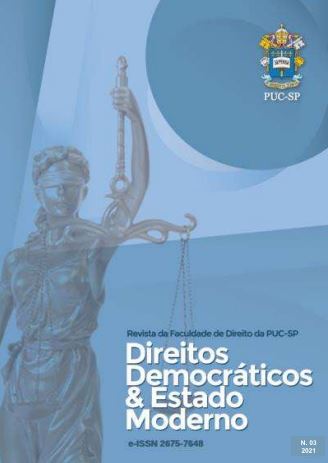Facial recognition technologies
a study from the context of digital and soft surveillance
DOI:
https://doi.org/10.23925/ddem.i3.53875Keywords:
Facial Recognition, Technology, Digital SurveillanceAbstract
The article assesses how facial recognition technologies are inserted in the context of subtle and digital surveillance, and what are the social risks caused by the use of these tools. It was found that modern technology transformed the structure of surveillance and made it possible to improve the mechanisms of facial analysis. New applications have emerged for facial recognition technologies, enabling them to serve “subtly” for vigilant purposes. It is concluded that there is a need for a critical assessment of its uses, especially in the face of social risks. It is exploratory research of the phenomenon, with theoretical and descriptive character and qualitative bias, which is proposed within a critical and reflective perspective on the technologies of facial recognition, such critical understanding, based on the references used,
little explored for research dealing with this phenomenon and thus having originality in this field of research. The deductive method, the historical-comparative procedure method and the indirect documentation search technique are used.
References
AMAZON REKOGNITION. Disponível em: https://aws.amazon.com/pt/rekognition/the-facts-on-facial-recognition-with-artificial-intelligence/. Acesso em: 20 de janeiro de 2020.
BARRICHELLO, Eugenia Maria Mariano da Rocha, MOREIRA, Elizabeth Huber. A análise da vigilância de Foucault e sua aplicação na sociedade contemporânea: estudo de aspectos da vigilância e sua relação com as novas tecnologias de comunicação. Intexto. Porto Alegre. UFGRS, PPGCOM, n. 33, p. 64-75. 2015. Disponível em: https://seer.ufrgs.br/intexto/article/view/50075. Acesso em: 20 de janeiro de 2020.
BIONI, Bruno Ricardo. Proteção de dados pessoais: a função e os limites do consentimento. 2ª Ed. Rio de Janeiro: Editora Forense, 2020.
BIRNBAUM, Emily. Facebook ends facial recognition photo tagging suggestions. Disponível em: https://thehill.com/policy/technology/459771-facebook-ends-facial-recognition-photo-tagging-suggestions. Acesso em: 19 de janeiro de 2020.
BRASIL. Lei nº 13.709, de 14 de agosto de 2018. Lei Geral de Proteção de Dados Pessoais (LGPD). Brasília, 2018. Disponível em: http://www.planalto.gov.br/ccivil_03/_ato2015-2018/2018/lei/L13709.htm. Acesso em: 13 julho 2020.
BRASIL. Medida provisória nº 954, de 11 de abril de 2020. Dispõe sobre o compartilhamento de dados por empresas de telecomunicações prestadoras de Serviço Telefônico Fixo Comutado e de Serviço Móvel Pessoal com a Fundação Instituto Brasileiro de Geografia e Estatística, para fins de suporte à produção estatística oficial durante a situação de emergência de saúde pública de importância internacional decorrente do coronavírus (covid-19), de que trata a Lei nº 13.979, de 6 de fevereiro de 2020. Diário Oficial da República Federativa do Brasil, Poder Executivo, Brasília, DF, 11 de abril de 2020. Disponível em: http://www.planalto.gov.br/CCIVIL_03/_Ato2019-2022/2020/Mpv/mpv954.htm. Acesso em: 19 agosto 2020.
EGGERS, Dave. O Círculo. São Paulo: Editora Companhia das Letras, 2014.
FIALHO, Yrana Miranda. Big Brother is watching you: Do “1984” de George Orwell às câmeras de vigilância presentes na contemporaneidade. Artigo disponível em: http://www.pucrs.br/direito/wp-content/uploads/sites/11/2018/03/yrana_fialho_20172.pdf. Acesso em: 16 de janeiro de 2020.
GATES, Kelly A. Our Biometric Future: Facial Recognition Technology and the Culture of Surveillance. New York: New York University Press, 2011.
Hardwell, Drew. Oregon became a testing ground for Amazon’s facial-recognition policing. But what if Rekognition gets it wrong? The Washigton Post, 2019. Disponível em: Amazon's facial-recognition AI is supercharging police in Oregon. But what if Rekognition gets it wrong? - The Washington Post. Acesso em: 13 março de 2020.
INIOLUWA, Deborah Raji; BUOLAMWINI, Joy. Actionable Auditing: Investigating the Impact of Publicly Naming Biased Performance Results of Commercial AI Products. Disponível em: https://www.media.mit.edu/publications/actionable-auditing-investigating-the-impact-of-publicly-naming-biased-performance-results-of-commercial-ai-products/. Acesso em: 20 de janeiro de 2020.
KAUFMAN, 2019. Alerta: as tecnologias de reconhecimento facial estão nos ameaçando. Disponível em: https://epocanegocios.globo.com/colunas/IAgora/noticia/2019/10/alerta-tecnologias-de-reconhecimento-facial-estao-nos-ameacando.html. Acesso em: 20 de janeiro de 2020.
LE DANDA, Manuel. War in the of Intelligent Machines. New York: Zone Books, 1991.
LEE-MORRISON. Lila. Portraits of Automated Facial Recognition: On Machinic Ways of Seeing the Face. Transcript Verlag, 2019. Ebook. Disponível em: https://www.transcript-verlag.de/978-3-8376-4846-1/portraits-of-automated-facial-recognition/. Acessado em: 16 de janeiro de 2020.
LUÑO, Antonio Enrique Perez. Derechos Humanos, Estado de Derecho y Constituicion. Madrid: Tecnos, 2005.
MAGRANI, Eduardo. A internet das coisas. 1ª edição. Rio de Janeiro: Editora FGV, 2018.
MARX, Gary T. Soft Surveillance: Mandatory Voluntarism and the Collection of Personal Data. Dissent, Fall 2005, v. 52, n. 4, p. 36-43.
MOGNON, Mateus. Desafio dos 10 anos' pode treinar sistemas de reconhecimento facial. Disponível em: https://www.tecmundo.com.br/ciencia/137950-desafio-10-anos-treinar-sistemas-reconhecimento-facial.htm. Acessado em: 22 de janeiro de 2020.
MOREIRA, André. Sobre o Direito e a Inteligência Artificial (e Robótica). Disponível em: https://www.oscorp.com.br/single-post/2017/01/26/Sobre-o-Direito-e-a-Intelig%C3%AAncia-Artificial-Rob%C3%B3tica---Parte-I. Acesso em: 22 de janeiro de 2020.
ORWELL, George. 1984. São Paulo: Editora Companhia das Letras, 2009.
PARISER, Eli. O filtro invisível: O que a Internet está escondendo de você. 1ª Edição. Editora Zahar, 2012.
PEDRO, Rosa Maria Leite Ribeiro; SZAPIRO, Ana Maria; RHEINGANTZ, Paulo Afonso. Dispositivos de vigilância e as cidades: tecnologia, política e vida cotidiana. Rev. Polis Psique, Porto Alegre, v. 5, n. 3, p. 26-44, dez. 2015. Disponível em http://pepsic.bvsalud.org/scielo.php?script=sci_arttext&pid=S2238-152X2015000200003&lng=pt&nrm=iso. Acesso em: 22 de janeiro de 2020.
PÉREZ, Xiomara Lorena Romero. El alcance del derecho a la intimidad em la sociedade atual. Revista Derecho del Estado, Bogotá n. 21, v. 1, p. 209-222, dezembro 2008. Disponível em: https://revistas.uexternado.edu.co/index.php/derest/article/view/499. Acesso em: 28 de junho 2020.
PRETA, Guilherme. Igrejas usam reconhecimento facial em fiéis. Disponível em: https://olhardigital.com.br/noticia/igrejas-usam-reconhecimento-facial-em-fieis/92998. Acesso em: 21 de janeiro de 2020.
PUGLIESE, Joseph. Biometrics: Bodies, Technologies, Biopolitics. New York: Routledge, 2010.
REGULAMENTO GERAL DE PROTEÇÃO DE DADOS. (GDPR/EU/2016/679). Disponível em: https://gdpr-info.eu/. Acesso em: 20 de janeiro de 2020.
SILVA, Camila Cássia. Hering é investigada por uso de dados de clientes via reconhecimento facial. Disponível em: https://www.tecmundo.com.br/seguranca/145544-hering-investigada-uso-dados-clientes-via-reconhecimento-facial.htm. Acesso em: 20 de janeiro de 2020.
SOLOVE., Daniel J. Nothing to Hide: The False Tradeoff Between Privacy and Security. New Heaven: Yale University Press, 2013.
STF. MEDIDA CAUTELAR NA AÇÃO DIRETA DE INCONSTITUCIONALIDADE 6.387 DISTRITO FEDERAL. Rel. Ministra Rosa Weber, DJ 24/05/2020. STF, 2020. Disponível em: http://www.stf.jus.br/arquivo/cms/noticiaNoticiaStf/anexo/ADI6387MC.pdf. Acesso em 18 out 2020.
STF. Pleno - Dados de usuários de telefonia. Youtube, [S. l], 2020. (170 min). Disponível em: https://www.youtube.com/watch?v=84M0nOQhQXo. Acesso em 08 out 2020.
WAYMAN, James. The Scientific Development of Biometrics over the last 40 years. In: The History of Information Security: A comprehensive Handbook. Amsterdam: Editora Elsevier, 2007, págs. 263-274.
WIGGERS, Kyle. MIT researchers: Amazon’s Rekognition shows gender and ethnic bias (updated). Disponível em: https://venturebeat.com/2019/01/24/amazon-rekognition-bias-mit/. Acessado em: 20 de janeiro de 2020.
ZUBOFF, Shoshana. Big Other: Capitalismo de Vigilância e perspectivas para uma civilização de informação. In: Bruno, Fernanda; Cardoso, Bruno; Kanashiro, Marta; Guilhon, Luciana; Melgaço, Lucas (Orgs.). Tecnopolíticas de Vigilância: perspectivas da margem. 1ª edição. São Paulo: Boitempo, 2018, p. 17-68.
Downloads
Published
How to Cite
Issue
Section
License
Copyright (c) 2021 Democratic Rights & Modern State

This work is licensed under a Creative Commons Attribution 4.0 International License.
This work is licensed under a License Creative Commons Atribuição 4.0 Internacional.
The authors grant the journal all copyrights relating to the published works. The concepts issued in signed articles are the absolute and exclusive responsibility of their authors.
DD&EM Magazine - ISSN 2675-7648

















